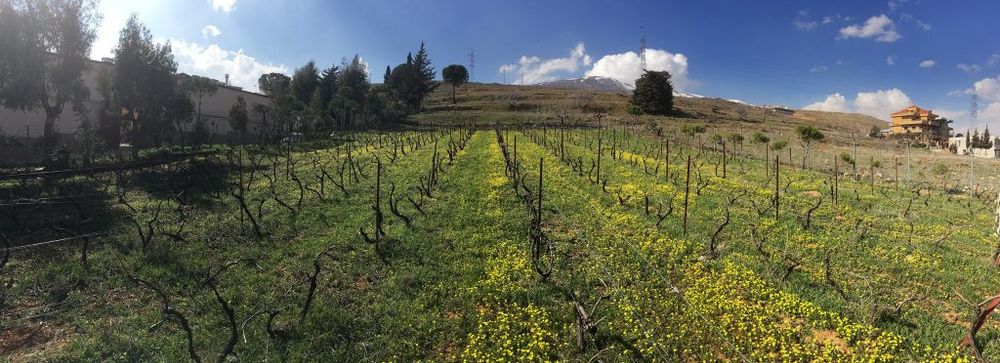If you are looking for wines with a story, then Lebanese wines have a head start on most wine producing countries. This is a country where the history and the traditions have always sold wine in the past. It now has quality winemakers making wines ideal for the premium on-trade. Some of which are at this week’s SITT tasting looking for new distributors.

Peter McCombie, right, taking in the Lebanase winemaking scene for himself
We love a new country in the wine business. It doesn’t matter if it is really ‘New,’ like say Denmark or ‘Newly Discovered/Revived/Improved’, like Turkey.
We like novelty. Lebanon is more like Turkey than Denmark – in more ways than one. Both countries can boast millennia of winemaking history that was largely suppressed during centuries of Ottoman rule, to the extent that neither was seen as a serious winemaking country until relatively recently.Both are now in the midst of a wine revival, though in both wine production can face political and cultural difficulties.
Novelty is fine but the enduring success of ‘classic’ wine styles suggests novelty isn’t always the easiest sell. There are still some of us old enough to remember when New Zealand Sauvignon really was a new thing, not a standard on the shelf.
The ‘Musar’ factor
The challenge for ‘new’ countries like Lebanon is to establish an identity for itself and its wines in export markets like the UK. Lebanon starts with a unique advantage that is also something of a handicap: its most famous wine Chateau Musar. Musar remains the only wine that people spontaneously mention when they find out I work in the wine business. They say something like “D’you know I had a Lebanese wine the other day?” Followed by “It was really good.” The only other wine that comes close is generic Rioja; they’ll say, without prompting “I really like Rioja.”
Musar is of course, if not the oldest winery in Lebanon, one of the oldest and arguably the best known in export markets, due to its compelling story and distinctive style, featuring notable volatile acidity.The downside for the rest of the Lebanese wine industry is that this one producer can define our perception of Lebanese wine. The rest of the industry can’t really define itself in opposition to Musar, so what does it have to offer the UK market, in positive terms?
The modern wines of Lebanon still show strong French influences: the majority of the predominantly red grapes grown originate in Bordeaux and southern France and any external winemaking links tend to be French too. Yet the wines are not copycat French wines. The majority of plantings are in the Bekaa Valley, in particular its western side, in the hills above Zahle, but there are producers experimenting in the Eastern Bekaa and across the mountains, closer to the Mediterranean in Batroun and Jezzine.
The Bekaa Valley enjoys long dry summers, cool nights and consistent rainfall and at an altitude of around 1,000m, produces mostly red and rosé wines with ripe fruit and generous proportions.

You can taste Chateau Heritage’s wines at the SITT tastings
Château Héritage in the village of Qab Elias near Zahle offers wines that range in style from very drinkable reds with a whiff of old world style to more ambitious and structured Bordeaux-Rhone hybrid blends, with a gastronomic white in the mix. These are wines indies could find really useful, as something a little different to offer customers who want to experiment but with a recognisable Mediterranean slant that isn’t too threatening.
Down the road in Kefraya, Caves Kouroum makes a range of mostly reds featuring Rhône and Bordeaux varietals and blends thereof, which offer great commercial values.
Across the mountains, Adyar, is an intriguing proposition: eight monasteries quite deliberately making “terroir’ wines, showing that you can make wine outside the Bekaa. While there is an accessible ‘estate’ range at affordable prices, specialist retailers and restaurants will find the individual monastery wines distinctive and indeed reflecting their distinct origins, with more ambitious pricing.
In the village of Metn, heading up into the mountains east of Beirut, Chateau Oumsiyat makes wines from a variety of vineyards and regions across the country. There is nothing ‘flashy’ here, but well made, affordable whites, roses and reds, often unburdened by oak.
To the south near the “largest pine forest in the Middle East” the village of Jezzine is home to the dynamic Karam Winery, founded by the charismatic Habib Karam, who shares his winemaking with being a commercial pilot. With vineyards enjoying a 1,000 metre elevation, the usual Rhône and Bordeaux plantings are joined by the likes of Albariño and Touriga Nacional. Deliberately trying to move away from French influences this winery makes some ambitious and distinctive wines that will appeal to sommeliers and specialist retailers.
- You can taste the wines from all these Lebanese wineries at this week’s SITT Tastings, including Bristol at the Bristol Museum on September 18 until 5pm and London at Lindley Hall on September 20 until 6pm. They will be part of the Wine Communication portfolio on stands 17 and 18, which is also showing producers from Wines of Hungary. All the wines being shown from Lebanon and Hungary are looking for distribution.
- Peter McCombie will be hosting masterclasses at both events on Lebanese wine and you can register here. In Bristol he is presenting on Lebanon at 1.45-2.15pm and in London between 4.40pm and 5.05pm.
- He is also working with Wines of Hungary at SITT and hosting masterclasses on Hungary at both events. In Bristol at 12.30pm-12.55pm and in London at 4pm-4.24pm.
- Wines of Hungary will be showing wines from the following producers at the show: St Andrea, Gere, Kovacs Nimrod, Barta, Balla Geza. Again they are all looking for UK distribution.
































